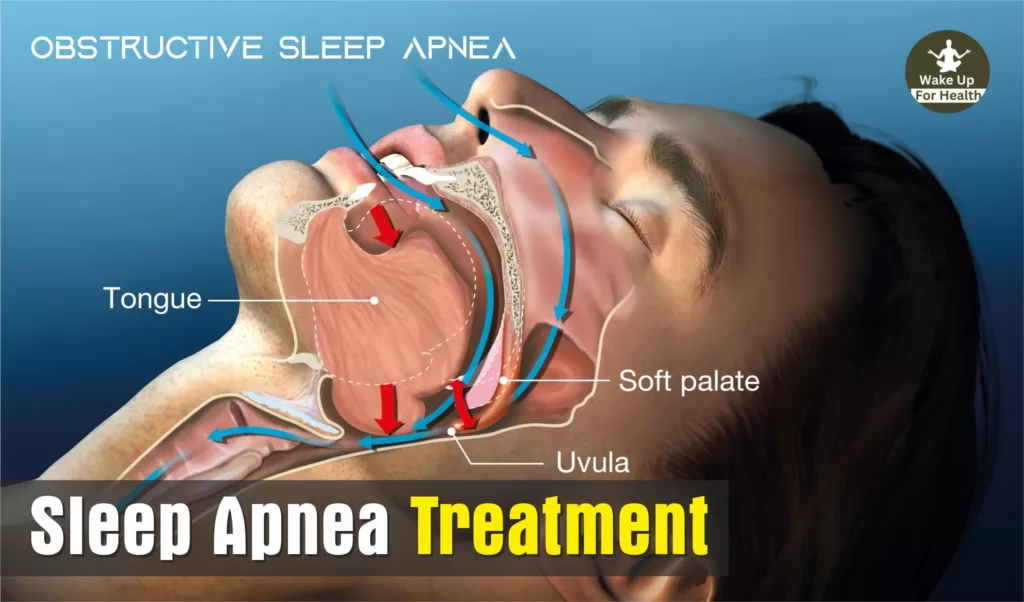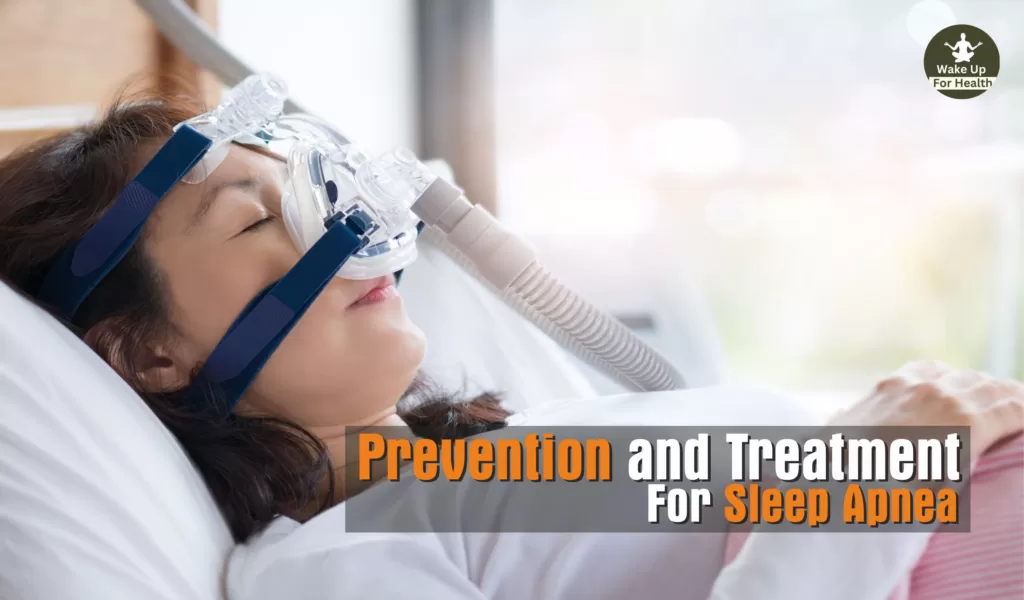Sleep apnea means interruption of breathing while sleeping. This is such a disease in which a person’s breath stops in sleep itself and they do not even know it. This problem of stopping breathing in sleep can be from a few seconds to 1 minute.
Although most people who snore loudly have sleep apnea, not everyone who snores does. In this disease, due to obstruction in the upper passage of the breathing tube, the flow of air does not happen properly.
If the obstruction in the patient’s breathing lasts for a long time, then the level of oxygen in the blood decreases. People who have fat deposits in the neck, tongue and upper abdomen are more likely to have this disease.
This weight of frozen fat narrows the diameter of the throat and pushes against the lungs, hence obstructing the airway during sleep. Lets know more about What is Sleep Apnea or Obstructive Sleep Apnea, Its symptoms, Causes, Types and Treatment.

Measures to Reduce and Prevent Sleep Apnea
1. Reducing Obesity
To reduce and prevent sleep apnea, it is necessary for the body to be healthy. With the increase in weight, the possibility of increasing sleep apnea also increases because excess weight and obesity cause problems in the contraction of the throat.
2. Physical Activity
Getting 30 minutes of physical activity or exercise every day can relieve the symptoms of sleep apnea.
3. Do Not Smoke and Consume Alcohol
Smoking and alcohol should not be consumed, due to which the muscles of breathing and the back of the throat become relaxed.
Do you Know? Mediterranean Diet Which Keeps Brain Young.
Types of Obstructive Sleep Apnea (OSA), Addressing Sleep Apnea

Types of this disease are:
1. Obstructive Sleep Apnea
This is the first and common type of sleep apnea. In this problem, there is difficulty in breathing during the obstruction of the air passage while the person is sleeping. Because of which most people snore loudly.
2. Central Sleep Apnea
The brain of the patient suffering from this disease fails to send signals to the muscles controlling the breath, due to which there is difficulty in breathing.
3. Co-occurrence of Obstructive and Central Sleep Apnea
If both these problems of this disease occur together in a patient, then it is called mixed sleep apnea.
Obstructive Sleep Apnea Test, Types and Symptoms, Effective Treatments
Following are some tests or tests to know about the symptoms of this disease.
1. In this test, the doctor uses a device while the patient is sleeping. This device controls many activities and levels, such as the activity of the brain, heart, lungs and limbs, and monitoring the level of oxygen in the blood with the help of this device.
2. Home tests: On the advice of the doctor, this disease can be easily tested at home, such as heart rate, blood oxygen level and breathing pattern. The oxygen level of a patient suffering from this disease decreases while sleeping and is higher while awake.
Read Also : A Healthy Body Has Anti-Aging Skin. How? Know More
Symptoms of Sleep Apnea (OSA)
The patient’s symptoms of this disease can be comprehended by the following list.
Interruption in breathing.
- Snore
- Fatigue
- Excessive daytime sleepiness
- Waking up frequently at night to urinate
- Decreased attention, alertness and concentration
Causes of Sleep Apnea (OSA)
Causes of this disease are:
- Having excess fat in the body.
- Increase in size of tonsils.
- Kidney problem
- Premature birth of the child.
- Infection in the brain.
- Stroke.
- Neuromuscular diseases like diseases affecting the system and nerves.
Risk Factors that Increase Sleep Apnea
1. Thick Neck
If a person has a thick neck, then their airway remains narrow, due to which there is a risk of increasing this disease.
2. Older Age
With increasing age, the risk of sleep apnea also increases.
3. Alcohol and Pain-relieving Medicines
Due to their use, the tissues of the throat become relaxed, due to which there is difficulty in breathing and obstruction of the airways.
4. Heart Related Diseases
People who have heart related diseases are more at risk of this disease.
How To Diagnose Sleep Apnea (OSA)?
Based on your symptoms, tests, and signs, your doctor will make an assessment of your condition. Your doctor will check the back of your throat, mouth, and nose during the physical examination for extra tissue or abnormalities. A sleep specialist will perform additional evaluations to diagnose your condition, including:
1. Polysomnography
During this sleep study, the patient is connected to equipment that monitors your heart, lung and brain activity, breathing patterns, arm and leg movements, and blood oxygen levels while you sleep.
Other sleep disorders, such as leg movements while sleeping or unexpected daytime sleepiness, that can cause excessive daytime sleepiness but call for alternative therapies may also be found with the use of this sleep study.
2. Home Test
In some circumstances, your doctor may offer you a home version of polysomnography to diagnose obstructive sleep apnea. Airflow, breathing patterns, blood oxygen levels, and potentially limb movements and snoring intensity are all typically measured during this examination.
3. Blood Tests
Blood tests may be done to check the levels of certain hormones.
4. Pelvic Ultrasound
This test can be done to examine the ovaries and look for cysts.
Must Read : How to recover from Food Poisoning?
Prevention and Obstructive Sleep Apnea Treatment

Lifestyle modifications may occasionally be used in OSA treatment.
1. Exercise and a Good Diet
It is important that a person follows a diet rich in vegetables, fruits and whole grains and gets plenty of exercise. Those who adopt these healthy behaviours can keep their weight in a healthy range. If the weight is high then obesity can increase the problem of this disease.
2. Avoid Alcohol and Smoking
Smoking and alcohol can cause inflammation in the upper airways, which can affect breathing.
3. Do not Sleep on your back
Sleeping on your back can increase the chances of softening of the tongue and palate in the airway, which can lead to airway obstruction, snoring, and sleep apnea.
4. Continuous Positive Airway Pressure (CPAP)
This problem is treated with a CPAP machine. This gadget can be utilised at home. This is a mask worn over the nose and mouth (or just the nose) while you sleep, through which pressure is applied to keep your airways open. If breathing machines don’t work, a doctor may also suggest an oral device.
5. Sleep Apnea can be Treated by Adopting Different Types of Measures.
- It is necessary for the treatment of this disease if advised by the doctor to use the CPAP machine.
- It is recommended to use tongue retaining and mouthpiece while sleeping for the patient suffering from this disease. It helps in reducing and opening the obstruction in the upper airways of the breathing tube.
- Mouth and tongue therapy on doctor’s advice strengthens the muscles. This therapy is helpful for treating this disease.
6. Surgery
For the treatment of obstructive sleep apnea, if the above measures do not help, the doctor may recommend surgery. There are three types of surgery involved:
- Tonsillectomy: In this the tonsils are removed and the airways are opened.
- Maxillary or Jaw Advancement: This surgery is done to enlarge the upper air passage. In this, the upper jaw and lower jaw are pushed forward.
- Tracheostomy: In this surgery, a hole is made in the windpipe through the front part of the neck. Then a breathing tube is inserted into it, which can help with breathing.
Adopt Healthy Lifestyle to Avoid Obstructive Sleep Apnea
1. Lose Weight
The problem of sleep apnea is more due to obesity. If a person’s weight is healthy, then the chances of him having sleep apnea will be very less.
2. Stop the Use of Alcohol and Addictive Drugs
Alcohol and addictive drugs cause damage to the nervous system. This affects the work of the brain. Chronic use of these substances increases the frequency of sleep apnea episodes and the number of episodes that occur during the night.
3. Don’t Smoke
Nicotine can make sleep apnea worse.
4. Exercise
The problem of sleep apnea can be overcome without losing weight, but for this it is necessary to exercise regularly. Before starting any exercise program, a person should consult a doctor.
5. Sleep on your side
When a person sleeps on his back or stomach, then the problem of sleep apnea becomes dangerous in him. That’s why side sleeping becomes necessary, it keeps the airway open.
6. Yoga
Regular exercise can increase your energy level, strengthen the heart and improve sleep apnea. Many yoga exercises are helpful in reducing inflammation and opening the airways. Yogic breathing, often referred to as pranayama, can be helpful in reducing sleep apnea. Sleep apnea is related to the lack of oxygen level in the blood.
Disclaimer : The article’s sole purpose is to provide you best collective and verified information. We do not recommend you any kind of medicine, treatment. You should only seek doctor or medical counselor Because there is no one better than him.
1 thought on “Sleep Apnea | Obstructive Sleep Apnea Symptoms, Causes, Types and 6 Treatment”